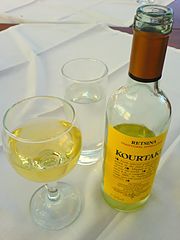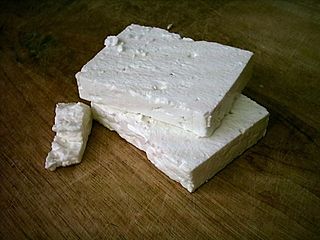The Greek kitchen is many from vacations in Greece known. In most small towns, however, one or the other Greek restaurant has established itself in the last few decades, so that you can eat "at the Greek" and refresh your holiday memories at a short distance from your home stove.
background

In itself, the Greek is a Mediterranean cuisine, in contrast to the Italian cuisine lettuce and vegetables have a higher priority. Differences result from the geographical conditions: the high mountain portion of 80% of the area of Greece, in which the breeding of sheep and goats plays a major role, is reflected in the frequent use of grilled lamb and goat meat and sheep cheese (feta). On the other hand, the country with its long coastline and the large number of islands has a tradition of fishing and processing seafood.
In the country grown olives, tomatoes, cucumbers, aubergines and zucchini can be found in numerous summer dishes, in the north of Greece own rice is grown and in the mountainous landscape numerous wild herbs and wild vegetables grow, which have been of great importance in Greek cuisine since ancient times. In winter, dishes based on potatoes and cabbage dominate. The winter dishes are rather unknown to typical summer guests in Greece.
There are also various regional kitchens in which the influences of the food of geographical neighbors and trading partners can be felt: in the north, influences of the Balkan cuisine can be felt, dishes and spices from the Ottoman - Turkish cuisine and the Levant came into the country via Constantinople See spices and dishes from the Arab world. Examples are the pita, the minced meat or the spices cumin and cinnamon.
Certain peculiarities of Greek cuisine such as the popularity of seafood or octopus, taramosalata (fish roe paste) but also sweets such as halva, which are exempt from fasting, are to be understood in connection with the longer and mostly more strictly observed fasting periods in Orthodox churches.
Many dishes are also known from Turkish cuisine. This is not surprising, since Greece was under Turkish occupation for 400 years and the same agricultural products are used in both countries.
A few years ago you could still go into the kitchen of the restaurants and look at the food. With the new EU regulations this is no longer allowed. Salt and pepper shakers, sugar bowls and vinegar or olive oil bottles on the table are now also banned. Everything must now be packed according to EU standards.
Ingredients and preparation
As a Mediterranean cuisine, Greek cuisine is characterized by plenty of salad and vegetables, sheep / goat cheese, lamb and goat meat, fish, seafood and olives, often seasoned with herbs and spices typical for this region such as Rigani (Greek: ρίγανη, oregano ), Mint, thyme, sage, cinnamon and paprika.
Typical Greek cuisine prefers main dishes from the grill or those that are prepared in the oven and either kept warm there or consumed only lukewarm anyway. Bread, mostly Greek white bread, is eaten with all dishes.
Meals in the daily routine

- breakfast: In Greece, as in other countries in the Mediterranean, this is usually modest. It usually stays with a coffee and later with a koulouri (ring made from white bread dough with sesame seeds), which is eaten between 10-11 a.m.
- Having lunch: In the big cities and by the tourists in the holiday resorts, snacks are often eaten, but in rural areas normal dishes around 3 p.m. The offer of fast food ranges from sandwiches and salads to typical Greek dishes, Gyros or Souvlaki. The gyros, schnitzel stacked on top of each other (minced meat is prohibited), seasoned with olive oil and herbs, is grilled on a rotisserie (similar to the doner kebab in the Turkish version) and the outermost layers cut off in the form of schnitzel. Meat skewers ("souvlaki") are also offered as a snack, in this case the same as the gyros in a toasted round pita bread with onions, vegetables, tzaziki sauce and some French fries (patates).
- Main meal: Many Greeks and most tourists take these in the evening. In the hot summer months, meals often don't start until 9 p.m. or 10 p.m., and guests who have sat at the meal beforehand can easily be identified as foreign tourists. For this reason, the warm kitchen does not open until 7.30 p.m., except in tourist locations.
Restaurants



The custom in Central Europe that everyone orders their own main course with side dishes on their own plate was rather unusual in Greece. In recent years, however, it has become more and more common.
Usually the waiter assigns you a table after entering a restaurant (or at least asks whether the desired table is free; the Greeks avoid tables in the sun anyway ...) and then receive a large carafe with chilled Water and a basket of bread. Then the waiter takes the drink order and brings the menu. This is usually done in two languages, in tourist destinations also with pictures. There are also in the busiest streets in front of the pubs stands with the menu to leaf through and "tow trucks" that try to guide passers-by into the restaurant.
The practice in the past of going to the kitchen as a guest to choose and order food and then to look in the pots and make a choice is now strictly prohibited for hygienic reasons. Even salt or pepper shakers are forbidden and only packaged bags are allowed. Also, no olive oil cans are allowed to stand on the table.
In a Greek restaurant, it is typical that the person who invites to dinner orders all the dishes, usually in abundant quantities. At the beginning of the sequence of dishes, a number of starter plates are usually served in the middle of the table, each of which can put together its own plate as desired. If grilled food is served as a main course, e.g. B. lamb ribs, the waiter puts the platter with the meat for everyone in the middle, everyone can use it as they please. There are also plates with salad and vegetables, respectively. Patates (Greek for French fries) on the table and everyone uses them when they're hungry. It is not uncommon for wine to be diluted with water in Greece, and drinking customs do not allow one to drink too much. No Greek leaves a locality heavily drunk and unsteady, tourists from Northern and Central Europe are immediately recognizable by such behavior.
The meal is seldom concluded with a café; a small dessert is usually served with it unsolicited; if you haven't ordered dessert with your coffee.
Eating together is a very important social event in Greece and can drag on for hours into the night. In addition to the food, social exchange and discussions about God and the world, including politics, are an important part of the evening.
In the tourist resorts, of course, the guests' wishes have been adjusted and it is normal for everyone to order a dish of their choice. Usually the table is billed as a total bill and you then have to divide up who has to pay what. But you can also say that individual billing is desired.
In general, fish dishes are very expensive if you order larger fish than anchovies. Unfortunately, fresh sea fish has also become rare in Greece and is correspondingly expensive.
- bar (μπαρ). in the bar (μπαρ, the Greek μπ (MP) stands for the letter B, while the Greek β is pronounced as a soft V) you get all kinds of coffee, tea and alcoholic beverages; In addition to packaged chips and crackers, small warm snacks are usually also offered.
- tavern (Ταβέρνα). as a taverna (ταβέρνα) a normal restaurant is called, in the fish tavern (ψαροταβέρνα, the first Greek letter ψ is reminiscent of the trident of the sea god Poseidon as a donkey bridge as an indication that seafood is offered here) is also offered fish.
- Istiatorio (εστιατόριο). a dining restaurant, which can meet high demands, is called εστιατόριο designated.
- Kafenion (Καφενείο). In the kafenio, the Greek coffee house, the pensioners sit with coffee and at the tafli (τάβλι), on the backgammon board, and discuss everything there is to discuss in this world until late at night. In the past, a visit to a Greek kafeneion was an absolute taboo for women, in male company or as tourists clearly recognizable, women are increasingly tolerated in this retreat of the Greek male world, but not welcomed.
Typical dishes
Appetizers (Orektiká)




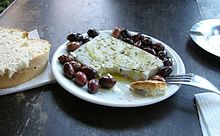
The various starters are mostly, but not exclusively, served cold and eaten with or without bread. Above all, this includes:
- tzatziki (τζατζίκι). a yogurt cream with cucumber, garlic and olive oil.
- Taramosalata (ταραμοσαλάτα). a fry cream.Features: Greek cuisine, Turkish cuisine.
- Tirosalata (Τυροκαυτερή). or Chtipiti, a cream made from feta cheese with (hot) peppers. This is what it is called in Northern Greece. They are called in southern Greece Tirokafteri or Kopanisti.
- Melitzanosalata (Μελιτζανοσαλάτα). Eggplant salad made from the spicy sauce of grilled eggplant.
- Skordalia (Σκορδαλιά). Garlic paste made from bread or potatoes, olive oil and fresh garlic. Is eaten with fish.
- Fava. a well-seasoned pea puree with capers, onions and olive oil.
- Dakos (Ντάκος). chopped tomatoes, olive oil and feta on rusks.
- Greek salad (Χωριάτικη σαλάτα). or Farmer's Salad (Greek: horiatiki salata), a salad made from tomatoes, cucumber, peppers, olives, onions and feta (sheep) cheese.
- Chorta. Salad made from wild vegetables that vary according to the season, drizzled with lemon, eaten cold (lettuce, dandelion, nettle, sorrel, cress, daisies, etc.).
- Dolmadakia (Ντολμάς). Grape leaves stuffed with rice, spices and onions.
- Ochtapodosalata (Octopus salad). Octopus salad with paprika, olive oil and vinegar.
- Fried vegetables. Vegetables fried in olive oil are very popular, such as Eggplant slices (Melitzanes tiganites), Zucchini slices (Kolokithakia tiganita), sweet or spicy Hot peppers (Piperies tiganites).
- croquettes (Κροκέτα). Potato croquettes filled with cheese are also very popular.
Are also popular Mezes (comparable to tapas in Spain), small appetizers that are often served with ouzo:
- Soupia (Σουπιά). Fried cuttlefish in a pan ( tiganiti) or grilled (psiti).
- Calamaria (Octopus). Pan-fried squids ( tiganita) or grilled (psiti).
- Ochtapodi Sharas (Octopus). Grilled octopus arms with olive oil and / or vinegar.
- Gavros (Γαύρος). Anchovies deep-fried, as saganaki with a sauce made from olive oil and mustard, or simply fried on the grill.
- Atherines tiganites (Αθερίνα). fried earfish.
- Sardeles Sharas (Σαρδέλα). Grilled sprat / sardine.
- Saganaki (Σαγανάκι). a piece of fried cheese.
- Gigantes (Γίγαντες πλακί). large oven-baked white beans in tomato sauce.
Soups (Soupes) and stews

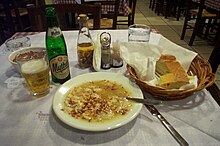
Hot soups are eaten in winter. In summer they tend to serve lukewarm to cold soups.
- Vegetable soups (χορτόσουπα). (Chortosoupa) and leek soup (Soupa Lachanikon).
- Trachanas (τραχανάς). the Greek variant of Tarhana.
- (Tanomenos) Sorvas. also Pontic soup called, is a soup that is cooked with grits or rice, yogurt and mint.
- Fasolada (Φασολάδα). the Greek bean soup, which is also known as the Greek national dish.
- Fakes (φακόσουπα). mostly a Greek lentil stew.
- Revithosoupa. a soup made from chickpeas.
- Fava soupa. Pea soup.
- Psarosoupa. Fish soups in different variations depending on the type of fish. Mostly made with avgolemono. The Kakavia is the traditional fisherman's soup.
- Giovarlakia (Γιουβαρλάκια). Soup with meatballs made from ground beef and rice.
- Kotosoupa. the Greek chicken soup, with rice, olive oil, onion, and avgolemono (lemon juice beaten with egg).
- Kreatosoupa. Beef soup with potatoes, carrots and celery.
- Patsas (πατσάς). a tripe soup.
- Magiritsa (Μαγειρίτσα). The soup consumed at Easter consists of liver acidified with lemon and other sheep innards as a filler.
Main courses (Kyria Piata)
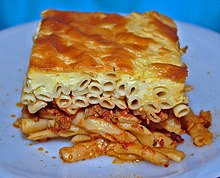

French fries (the Greek πατάτες are only fried once and cut by hand), rice or kritharaki (small noodles in rice grain format) are often offered with all main dishes. The vegetable side dish also varies, with green beans, eggplants and okra being common. Greek cuisine uses a lot of lamb and goat meat. Fish is one of the most popular main dishes, be it in soups, casseroles or marinated dishes, with larger, noble fish being prepared on the grill. Chicken (κοτόπουλο, kotopoulo) and rabbit (κουνέλι, kouneli) in many variations enrich the menu of Greek cuisine.
- Gemista (Γεμιστά). Vegetables filled with rice, mostly tomatoes, peppers, eggplant or zucchini, but also potatoes.
- Fasolakia (Φασολάκια πράσινα λαδερά). Green beans in tomato sauce.
- Bamies. Okra in tomato sauce.
- Briam (μπριάμ). Eggplants, zucchini and peppers in the oven.
- Imam Baildi. braised eggplant with plenty of garlic.
- Giouvetsi (Γιουβέτσι). a stew with kritharaki (Greek noodles in rice form) and lamb.
- moussaka (Μουσακάς). a casserole with fried potato slices, minced meat, aubergines fried in olive oil and interlayers of bechamel sauce.
- Pastitsio (Παστίτσιο). a pasta casserole made from minced meat and macaroni.
- Gyros (Γύρος). is a traditional Greek style of seasoned pork (occasionally chicken) from the vertical rotary grill, which is cut into schnitzel form. Gyros is only served as a simple, quick dish at food stalls or smaller grill restaurants (ψησταριά, psistariá) where it is served in pita bread. As a rule, restaurants in Greece do not serve gyros, unless the restaurant has a snack bar, which often stands Gyros on the plate with french fries (patates) and side salad on the menu.
- Souvlaki (Σουβλάκι). Meat skewers of different sizes, with either lamb or pork, are almost exclusively served in snacks and in (excursion) restaurants that are equipped with a charcoal grill (sta Karvouna) are equipped. The small lamb skewers have a long tradition in the rural population.
- Kontosouvli (Kondosouvli). the big brother of the souvlaki skewer with pickled pork or mutton.
- stifado. a casserole made of veal or lamb, lots of small onions and cinnamon sticks. Very often from rabbit meat, more rarely from octopus.
- Bifteki. Meatballs made from minced beef, with or without cheese filling.
- Loukaniko. grilled sausage.
- Soutzoukakia (Σουτζουκάκια). elongated meatballs made from minced meat.
Dessert (Epidorpio)


Traditionally, seasonal fruit or homemade ice cream is served as dessert after dinner. Sweet desserts were more likely to be served with an afternoon coffee, but have also become common as desserts. These “sweet” desserts can also be found in a similar form in Turkish or Middle Eastern cuisine and are probably of Byzantine origin. They are very sweet and heavy and often soaked in honey syrup. These include
- Baklavas (Μπακλαβάς). a pastry made from puff pastry or filo pastry in honey or sugar syrup, filled with chopped walnuts, almonds or pistachios.
- Galaktobureko (Γαλακτομπούρεκο). Semolina pudding covered in filo dough.
- Kadaifi (Κιουνεφέ). Pastries made from noodle-like threads of dough filled with semolina and drizzled with warm sugar syrup.
- Loukoumades (Λουκουμάς). Cakes fried in oil in honey syrup.
- Moustalevria (Μουσταλευριά). or Moustokouloura, is a traditional Greek type of grape must pudding mixed with flour and cooked thick.
- Halva (Χαλβάς). Cakes made from semolina and nuts poured over sugar syrup.
- yogurt (στραγγιστό γιαούρτι). It is also often served as a dessert mixed with honey and walnuts, although the is served as Greek yogurt known cream yogurt used.
- fruit. In summer, instead of desserts, fruits are also served, such as melons, honeydew melons, grapes and apples.
Easter and Christmas cookies
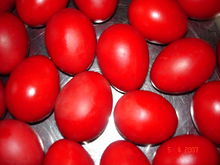
There is a large number of regional baked goods on offer for the ecclesiastical Easter celebration. Yeast plaits in particular are baked in different sizes at this time. Here, painted eggs are also used for decoration, but they are not consumed.
- Tsoureki (τσουρέκι). Hefezopf.
In the run-up to Christmas, cookies are baked, which are by far the most popular
- Melomakarona (Μελομακάρονο). Cookies soaked in diluted honey.
- Kourampiedes. Almond cookies pickled in powdered sugar. A specialty from the northern Greek city Kavala.
beverages
Basically, when eating, water is always placed in the carafe or water bottle and water glasses on the table.


- water. Still water (νερό, nero) is almost naturally delivered to the table in many restaurants and taverns in the form of a carafe or bottle of non-carbonated water in summer. Still water is much more popular in Greece than sparkling water, this one soda called water is usually ordered for digestion after a meal.
- Portokalada. Orange lemonades will be Portokalada called; for the (often freshly squeezed) orange juice, the term Chimos Portokalada (χυμός πορτοκαλιού) naturalized. In Greece, Fanta has a high percentage of orange juice and is available with or without carbon dioxide.
- Lemonada. Lemon soda, served only with carbonic acid.
- Wine. Of great importance is the Greek wine, which is ordered not only in the bottle but in copper or glass jugs as quarters, halves or liters in taverns. Loose wine (Chima-χύμα) is significantly cheaper than bottled wine in restaurants.
- Retsina (Ρετσίνα). a dry white wine with resin whose taste you have to get used to.
- ouzo (Ούζο). Ouzo with a pronounced aniseed aroma is known for spirits, which is often drunk as an aperitif and ordered in taverns with some mezedes, mostly octopus or mussels.
- beer. (μπύρα, Bira) is also popular in Greece. Until the 1960s, the market was dominated by the traditional Fix brewery, which has Bavarian roots. Later, the Amstel, Heineken, Löwenbräu and Henninger brands were also brewed in Greece. Meanwhile there are also new Greek brands, including myth and Alfa. Beer is mostly sold as bottled beer and is a seasonal drink.
- Liqueurs. as well as aperitifs in general were traditionally produced in Patras, provided one made the aperitif wine Mavrodaphne counting, this (in addition to the Tentoura) is the only one on the market. Cut-throat competition, mostly among Italian manufacturers, has been taking place in Greece since the 1930s.
- Metaxa (Μεταξά). is the most popular Greek brandy and, in addition to the distillate, also contains a secret mixture of herbs as an ingredient. The different versions differ primarily in the length of time they are stored. The simplest is the three-star Metaxa, but it is only offered in a few markets. Mainly five-star (stored for at least five years) and seven-star Metaxa (stored for at least seven years) are sold.
coffee
is the most popular non-alcoholic drink far ahead of tea.

- Greek coffee (τούρκικος καφές). (Ελληνικός καφές, kafes or explicitly to be ordered as greek coffee) is boiled like the mocha with the coffee powder. It can be prepared with or without sugar, as desired. When ordering, it is specified whether you want a single or double (double greek) and whether or how much the coffee should be sweetened: not at all (sketos), a little in sugar (me oligi) or in high sugar (βαρύγλυκο varigliko). Ordering one Tourkikos or "Turkish Coffee" has been a faux pas since the Turkish occupation of Northern Cyprus in 1974. Coffee roasters are still common, where customer requests regarding the blend are also met.
- Café frappé (Φραπέ). is a Greek invention that is often preferred to Greek coffee in the summer months. In a plastic cup with a drinking straw, Nescafé, ice cubes and water with or without milk and sugar are frothed with the hand blender and enjoyed at every opportunity on the beach or while walking and waiting. You can drink it either with milk (me gala) or without it (horis gala) and state how much sugar you want when ordering: "sketo" (without sugar), "metrio" (1 tea spoonful of sugar) or "gliko" (2 teaspoons of sugar). The most common variant is "metrio me gala" (medium sweet with milk). For a few years, however, the Frappe has gone out of fashion and is no longer ordered by younger locals and almost only by tourists.
- Freddo (Φρέντο εσπρέσο). Freshly brewed espresso is poured onto ice with a little sugar and shaken briefly. Like other coffees, this is prepared with or without sugar, as desired. It is exactly the same with the very popular Freddo Cappuccino (like Fredo but with milk foam). The milk foam is of course beaten cold, not warm. There is a choice of cinnamon or chocolate powder on top of the foam.
- Neskafé. (Νεσκαφέ) plays the role that filter coffee plays in Germany.
- tea. Tea drinkers in Greece prefer the local mountain tea. The diptam dost is still widespread in Crete.
- Condensed milk. is sold unsweetened or mostly with sugar and is very important and, unlike milk powder, is available everywhere in Greece. For self-caterers, it is advisable to bring the milk powder from their home country, which is not perishable in the summer heat, in order not to be confronted with the problem of opened sticky condensed milk cans on the campsite.
Food
Self-caterers will find a wide selection of groceries in the Greek grocery stores in almost every village. One is amazed which assortment is in stock in a tiny little grocery store (παντοπωλείων, Pantopoleion). Local fruits and vegetables are best found in the markets and at stalls along the road. The large supermarkets also have plenty of choice.
The “greed is cool” buying behavior so typical for German consumers, ie only buying the cheapest, does not exist among the Greeks. You are willing to pay more for good taste and quality. If you only want to buy groceries as cheaply as possible on vacation, you will find it at Lidl or the other major Greek chains. There is also the cheap “sheep cheese” made from cow's milk.
- Fruits & vegetables. the offer varies seasonally, tomatoes, cucumbers, aubergines and zucchini are almost always available, in the winter months from the greenhouse. Water and sugar melons from June to September. Strawberries and cherries are available from April, apricots a little later, peaches from August, table grapes in autumn, apples, kiwis and oranges in the winter months; in spring the oranges are uniquely sweet.
- olive oil (Ελαιόλαδο). are available in bottles and canisters in different qualities. There is the green oil that is pressed from unripe olives and the yellow olive oil from ripe fruits. The former is often used for salads, the yellow one more for cooking. Green olive oils can scratch your throat. This is not a poor quality, but typical of particularly unripe olives. Olive oil is one of the most counterfeit foods (besides honey). One should beware of supposedly cheap offers on the street. It is best to buy from a farmer after tasting the oil if you want to take several liters home with you.
- yogurt. Yogurt is made from cow, sheep or goat milk. The most common and cheapest is that made from cow's milk. There is also a type of quark (stragisto yogurti), which is used, for example, to prepare tzatziki.
- Feta (Φέτα). The feta cheese, which is essential for every Greek salad and kept in brine, is often packaged or available open at the counter (in metal canisters). It is worth comparing cheese from different manufacturers.
- Kaseri (Κασέρι). Greek hard cheeses have a special taste that differs significantly from the cheeses commonly used in Northern Europe (Gouda, Edam, etc.). Usually it is quite salty. The taste is similar to Parmesan cheese. Prices are well above feta.
- flesh. There are in butchers, which can be recognized by the rather empty showcase and the large chopping stick, the meat (chicken, κοτόπουλο or kotopoulo), pork and lamb, partly also ready-made skewers (souvlaki) and poop steaks (bifteki) is stored in the refrigerator and brought out according to customer requirements. The Greek farmer's sausage is cut according to the customer's weight or according to the number of pieces.
- fish. is not only expensive in the inland but also in the ports of the islands, even when sold directly from the fishing boat. In general, fish dishes are expensive if you order fish larger than anchovies. Unfortunately, due to the overfishing of the sea, fresh sea fish has become rare in Greece and is correspondingly expensive. Greek Fish Translated: A Guide to Greece’s Seafood .
- bakeries. (αρτοποιείο) in the morning the oven-warm Greek white bread is sold, with dough snails or triangular dumplings with spinach or feta filling are popular meals for day trips. Certain dry biscuits are on offer in the bakeries in order to experience full enjoyment, but you have to go to the sugar bakery or Go to the pastry shop.
- Confectioner. (ζαχαροπλαστικής) Confectionery that please the eye and the palate: in addition to an often huge selection of different cakes, sheet cakes, self-made cereal bars, there is also ice cream. The classic Greek ice cream sticks (small vanilla ice cream on a stick with a chocolate coating) are often still made locally and are bought from the freezer by weight. Of course there are also the much more expensive made-up ice cream cornets at every kiosk.
Popular snacks

Koulouri
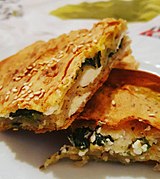
Pitas

Bougatsa
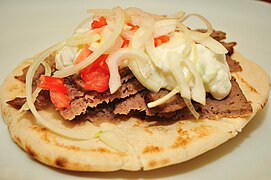
Gyros on pita
- Koulouri (Κουλούρι). Bread dough rings with sesame seeds. They are by far the most popular snack for morning coffee.
- Pitas (πίτα). Pitas are filled bread cakes with different fillings and are extremely popular. They are filled with feta (Tiropita), with a spinach and feta filling (Spanakotiropita), with a sausage filling (Lukarnikopita), with a cheese and ham filling (Zambonokaseropita), and much more.
- Bougatsa (Μπουγάτσα). Sheet cake or puff pastry pieces with different fillings. The most popular variants are filled with feta (Bugatsa me Tiri) or semolina pudding (Bugatsa me Crema).
- Gyros (Γύρος). Similar to the Turkish doner kebab, the Greek version is a roll or flatbread (pita) filled with meat, onions, french fries but not cabbage, like the doner kebab. You can get it at the many gyros stands at low prices.
Culinary calendar
Culinary delights are often seasonal. Fruits and vegetables are tastier when they are ripe; meat and fish are also subject to seasonal influences. For the popular Greek salad in winter, of course, only greenhouse tomatoes are used, the taste of which is not comparable to outdoor tomatoes in summer. If you want to eat well, you should choose the fruit, vegetables and salad that are in season. Every season of the year, festivals are celebrated that have a general theme or focus on certain foods. There are also drinking and eating habits throughout the year that arose from religious traditions such as fasting times.
literature
- Cooking on the holy Mount Athos. The book can be found in monastery shops in Greece, but mostly only the English version. Alternatively there is the book at Mount Athos e-shop. The recipes can be found online here
- If you want to enjoy Greek cuisine at home, you will find the appropriate recipes in Koch Wiki under Category: Greek cuisine. Have fun cooking at home.
- Greek kitchen- many delicious original recipes




.jpg/350px-Tzatiki_(3656301454).jpg)












.jpg/320px-Sepia_officinalis_(aquarium).jpg)





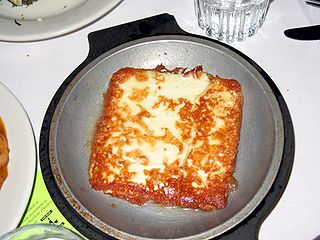













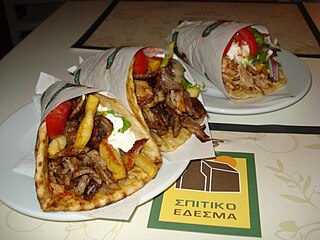

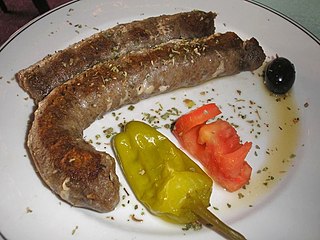

.jpg/350px-Baklava(RobertK).jpg)







